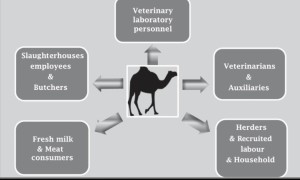
"The Hidden Threat of Camel Brucellosis: Understanding the Risks and Prevention Strategies"
Camel brucellosis is a significant zoonotic disease impacting the health of camels and posing risks to human health. The disease is caused by the bacteria Brucella melitensis and Brucella abortus, which primarily affect livestock but can also infect camels. The disease is transmitted through direct contact with infected animals or their secretions, including milk, urine, and placental tissues. Transmission can also occur through contaminated feed, water, and equipment. Humans can contact brucellosis through the consumption of unpasteurized dairy products or direct contact with infected animals, leading to severe health issues.
Diagnosing camel brucellosis involves a combination of clinical signs, serological tests, and bacterial isolation. Key diagnostic methods include Rose Bengal Test, Antigen Rapid Camel Brucella Antibody Test, CFT, ELISA and PCR. Regular surveillance of Brucellosis in camel populations is essential for early detection and monitoring of the disease. Surveillance programs often involve sampling camels at markets, slaughterhouses, or during outbreaks to identify and control the spread of the Bacteria. Detecting Brucella in camels is critical for preventing human infections and managing the spread of the Bacteria. The PCR or CFT test is used to detect and diagnose infectious disease and can confirm positive cases of in camels. However, PCR or CFT test is time consuming, at Fujairah Research Centre Antigen Rapid Camel Antibody test kit has been used to provide fast and reliable test results of Brucella with high correlation. It can be used as screening test for large number of camels. The Whole Blood, Plasma, Serum or Milk specimen collected and examine by Camel Brucella Ag test kit with sensitivity 100% and specificity 95.6%. Surveillance using serological tests, as well as tests on milk such as the milk ring test, can be used for screening and play an important role in campaigns to eliminate the disease. The main way of preventing brucellosis is by using fastidious hygiene in producing raw milk products, or pasteurizing all milk that is to be ingested by human beings, either in its unaltered form or as a derivative, such as cheese. Another important aspect of Brucellosis prevention is public awareness. People in endemic areas demonstrated a high lack of knowledge and understanding of the disease and its causes. Preventing camel brucellosis requires a multi-faceted approach involving vaccination, regular screening, biosecurity measures, public education, and collaboration between stakeholders. By implementing these strategies, we can protect the health of camels and reduce the risk of zoonotic transmission to humans.
